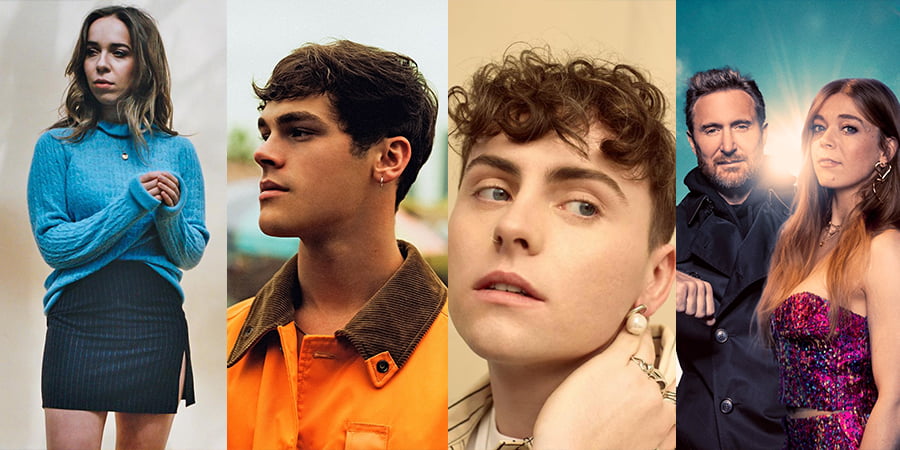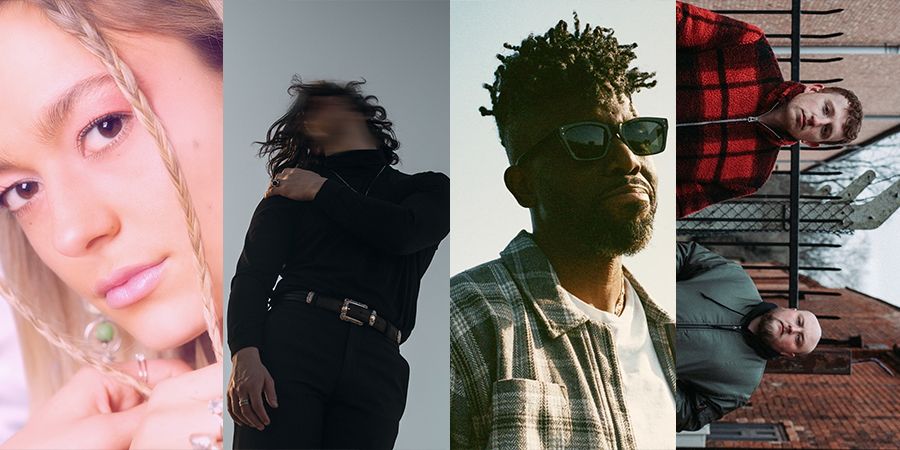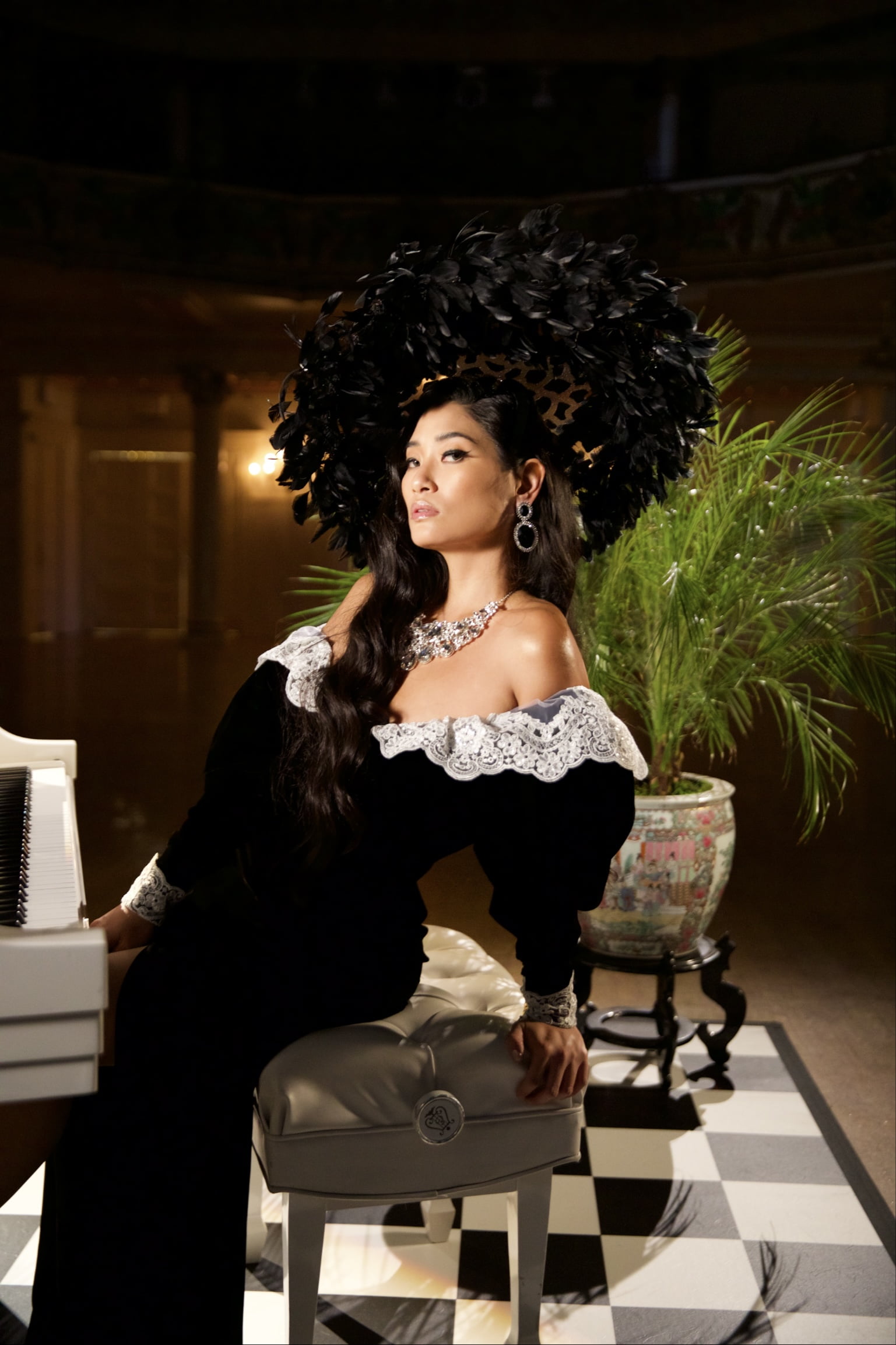
Chloe Flower
A Conversation with Classical Music’s Cover Girl
Nicknamed the “Millennial Liberace”, Chloe Flower is among classical music’s most innovative composers. Not only is the powerhouse pianist a member of the Board of Directors of the Liberace Foundation, but she is also a stalwart supporter of music education, and uses her distinct sound to democratize the access and appreciation of classical music to a more diverse audience. Though Chloe is known for performing classical covers of popular hip-hop songs (Ariana Grande’s Thank You, Next and Drakes Passionfruit), her production skills are uniquely impressive, as she continues to score and produce her own compositions.
Flower has singlehandedly bridged the gap between two of music’s most disparate genres– classical and hip-hop– while simultaneously honing her own category of music, “Popsical”–the merging of pop and classical. Though she’s been playing piano since the age of three, Chloe’s classical trajectory took a more prominent shape when she was introduced to mega-producer Babyface in 2011, a relationship that further cultivated her aptitude for production, composing, and sound engineering, all while she expanded on the conventional constraints of the classical genre. Since 2011, Flower has collaborated with the likes of Nas, Celine Dion, Timbaland, Meek Mill, and in 2015 she scored A Ballerina’s Tale, a documentary detailing the career of American Ballet Theatre Ballerina, Misty Copeland. It was her 2019 Grammy’s performance alongside Cardi B, however, that catapulted her career into stardom. The vigor with which her fingers pounded the keys, paired with the expressive opulence of her attire, made her an overnight viral sensation and formidable fashion muse. And while Cardi suggested Chloe’s attire for the evening, it was Chloe who arranged for Cardi to borrow the bedazzled Liberace Crystal Piano for the iconic performance.
Solely clad in couture for performances, the dynamism of Chloe’s renditions is formidably matched by her sartorial splendor. While the connection between audience and pianist is traditionally restricted to keynotes in the absence of lyrics, Chloe uses high fashion silhouettes to elevate the sensory experience of her audiences and further invigorate her connection with them. In fact, it is with her thigh-high stiletto Zanotti boots that she continues to stomp out stigmas of how a classical music composer should look, dress, and identify with her fan base.
High spirited and sweltering with physical expression, Chloe’s stage presence exudes the kind of elation and affection that makes the audience feel as much integrated into the dynamism of her set as her piano keys are. In these times of global isolation, Chloe continues to engage audiences on a digital platform, where she performs a mix of renditions and newly released material on the Liberace glass touring piano on loan to her at her New York City residence.
On the eve of her new release, Carol of the Bells, a reinvented holiday carol co-produced and written by Babyface, Chloe conversed with 1883 about her animated and unparalleled performance style, classical music’s newfound accessibility, and the evolution of her self described genre of “Popsical” music.
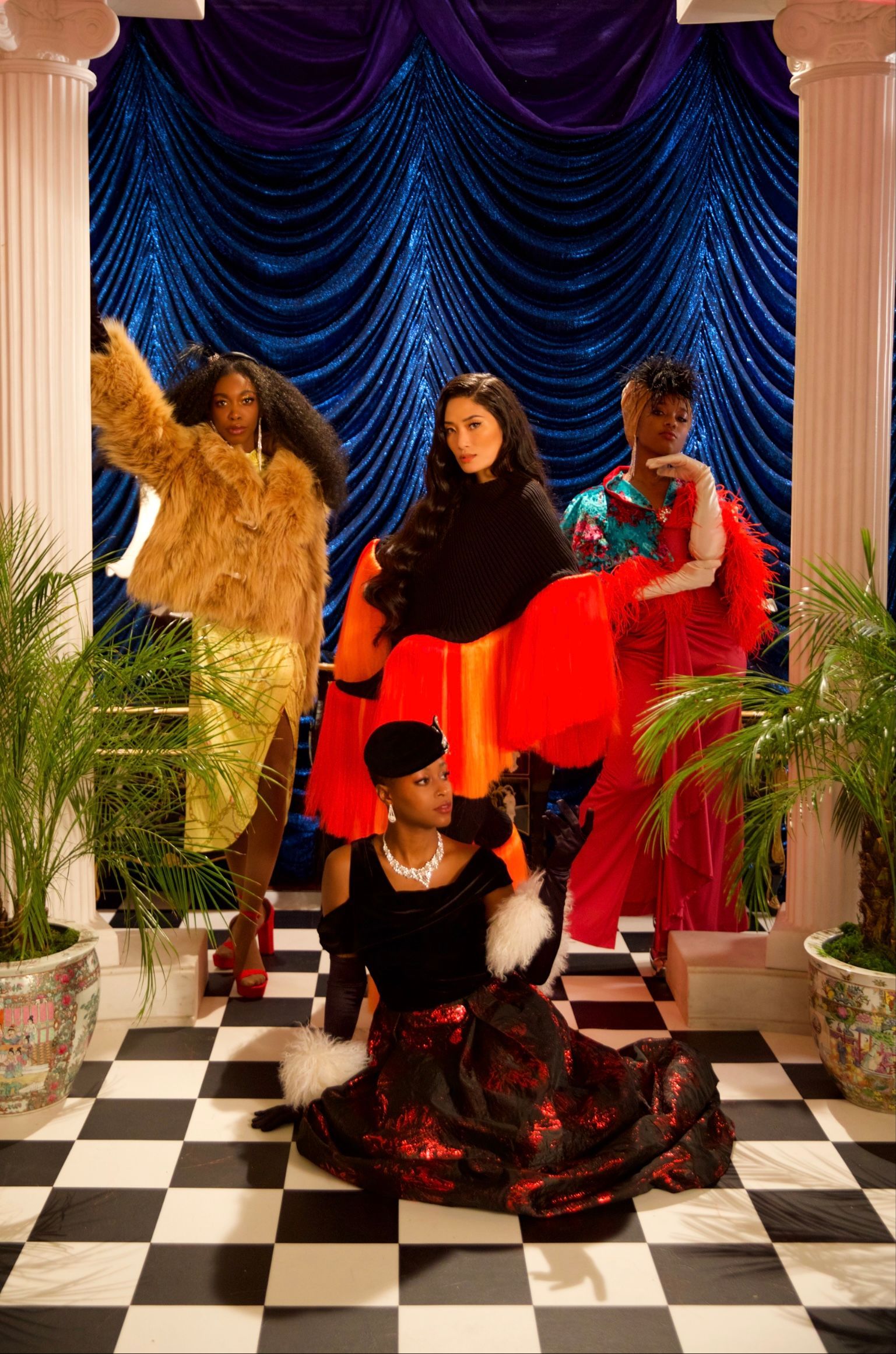
Dress Stina Randestad
Your newest single, Carol of the Bells is a timely holiday treat. How did this rendition come about?
Carol of the Bells was something that I’ve been working on for many, many years. I just never…had it right, and then I ended up working on this song literally between 1am-10am. I would scream into my pillow out of frustration sometimes…like, “Oh my gosh, when is this song going to be over?!” I just couldn’t get it right, so that song in particular, I [completed in] what I call “rapper hours”. I call it the “rapper song”, because I did it during rapper hours, and would go to bed at 9am.
Is that what rappers do? They work late in the studio during those hours?
Yeah. I call it “rapper hours” as a joke to myself, but every time that I work with producers in hip hop, or even pop, a lot of them like to start sessions really late. They call it “magic hours”‘. A lot of musicians that I work with like to start really late– 10pm, 11pm in L.A. I have a room in Babyface’s studio in Los Angeles, and sometimes I would be working in the studio, and he would leave and say “Goodbye! See you tomorrow in the studio, in the same clothes, probably.” [Laughter]. He would get back to the studio early in the morning, and I would still be there, in the same clothes.
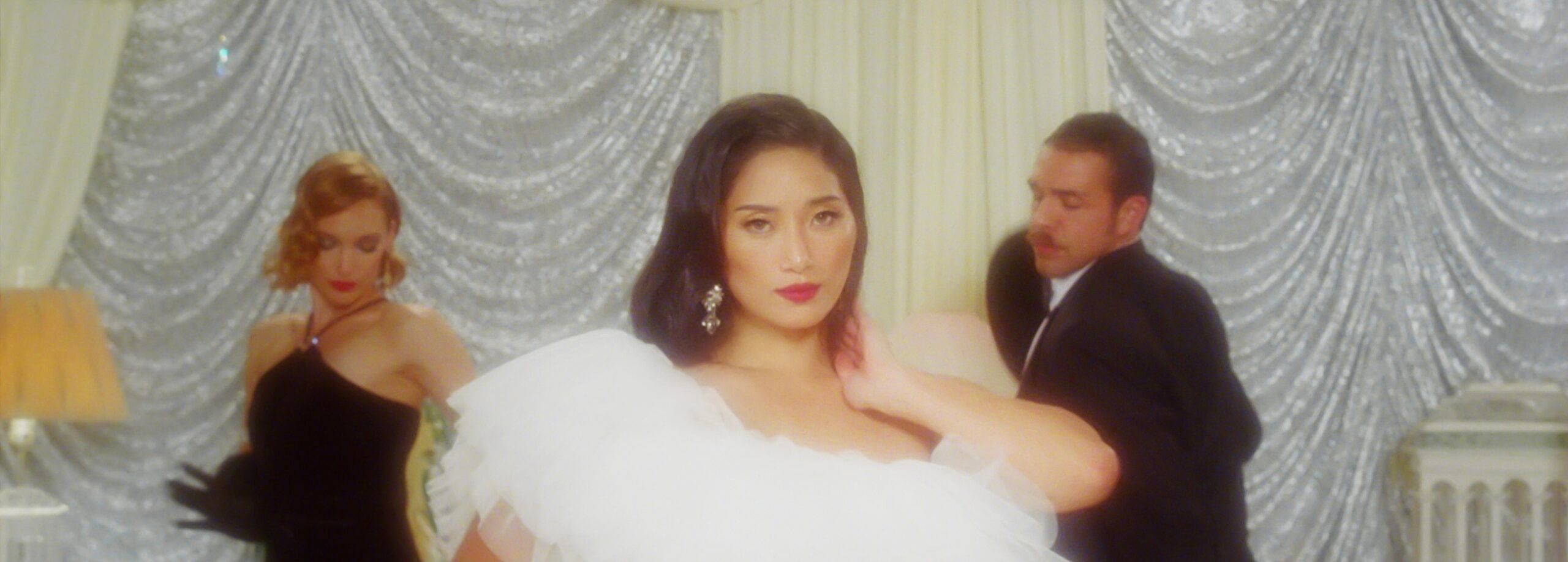
Dress Alessandra Rich
Earrings Vintage 1930’s Earrings from Private Collection
There’s a bit of gospel in the sound of Carol of the Bells. How did this contemporary sound come about?
In Carol of the Bells Babyface put a choir in and changed the words…he rewrote the lyrics and gave them the Babyface swag…The music is public domain, but the lyrics [to the song] are an actual poem, written and copyrighted. So we decided, let’s just write the lyrics and give it more of that R&B swag. And so we had an amazing choir— I wish it had been bigger— but I think for a live performance, we’re going to go full gospel.
How did your relationship with the legendary Babyface come to fruition?
Well, he is an iconic producer, obviously…and such an amazing songwriter. I actually googled him as a producer because I had seen him perform, and knew his work, and his manager, Susan Markheim–who’s now my manager as well– she responded to my random email (I found her email on the Internet). And she sent it to him with my demo in an email…and he was interested, so I flew to L.A. a month later, and he signed me…I literally found him on the Internet.
When you were typing the keypad and contacting Babyface’s manager, did it ever cross your mind, “His manager is soon going to be my manager?”
You know, what I think helped me is that I’ve never been afraid of the word “no”. I needed a producer, and I remember that I had [previously] met Babyface, and he’s iconic and amazing, and the only producer that I really knew…I come from classical music, so I didn’t really know producers like that. He was the only one I could think of, so when I googled him, I typed “producer, Babyface” and Susan’s name and email came up somehow. I took a chance…he was the first and only person that I contacted. I don’t want to sound corny, but I always say that it was destiny…Perfect circumstances, and perfect timing.
I heard about Babyface’s involvement in the way that your career has taken shape, and it reminded me of the role Clive Davis had in helping to flesh out Whitney Houston’s career. Do you think it parallels that, or would you say it’s something different?
I don’t know that much about Clive Davis and Whitney Houston’s career, other than that he signed her, and they were so close, and he signed her when she was very young. So in that sense, I think it could be similar–
He was the architect of her career, in really helping her map out her trajectory.
I think for me, Kenny [Babyface] has been more of a mentor for me musically. He’s a true artist, at the studio five days per week, working 10-12 hours per day the whole time. For me, that was such an inspiration seeing someone who works so hard, even after he’s had so many hits, he continues to work. Also, he’s taught me all of the tools that I needed to create. For instance, Carol of the Bells I arranged it, I did all of the string parts, drums, etc. I really produced and created this piece, and I wouldn’t have been able to do this without his mentorship…Clive didn’t really teach Whitney about writing music; Kenny actually taught me how to use software, and how to arrange. He taught me about pop songs format, so I feel like his influence on my actual music was just so so much. His contribution to how I’ve learned, and what I know as a producer, and as a composer…I would not be able to use that software had I not spent that time in the studio with him and his team.
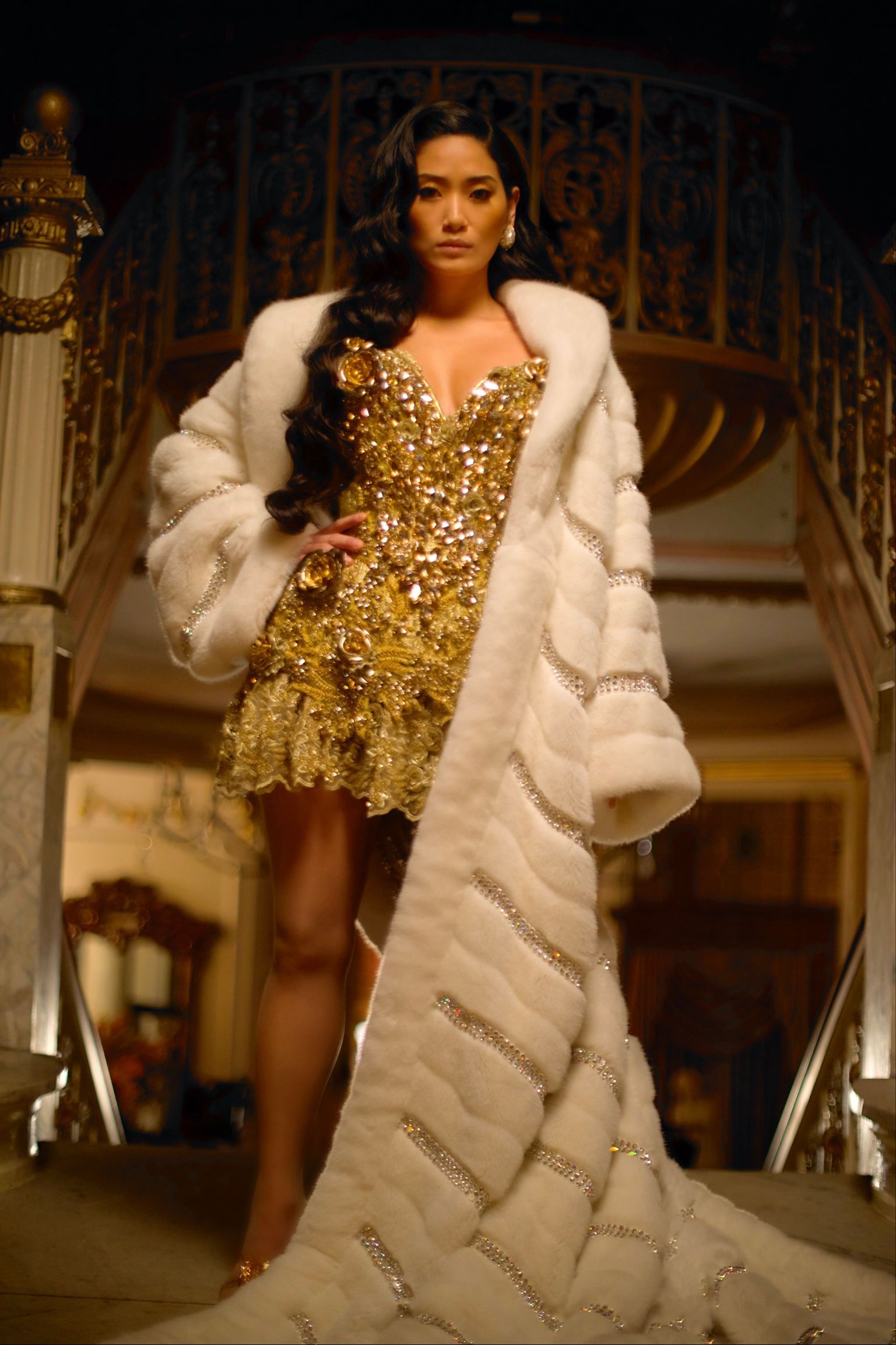
Liberace Faux Fur Coat with Rhinestones, made as a replica for the move Behind the Candelabra
Dress Vintage Gucci Gold Python Shoes
So you’re one of how many women in the business that actually wears all of the hats in musical production/arrangement?
There’s so many [of us]. We’re just underrepresented, which is why representation is so important for us as women, especially as women of color in the music industry. When you see women producers, writers, composers that are out there, it gives you that confidence, or extra push that you can do that, too. When you google female composers, there are really only a couple that will show up…I don’t think that’s a coincidence– we’ve been underrepresented for years, but I think that’s all changing.
In addition to being a female composer, you’re also a fashion icon. Your visual presentation parallels the dynamism in sound for what you’re performing. How important to you is your image?
My mother taught me about fashion…I think the first thing I ever read was Harper’s Bazaar. I would read these magazines, and my mom loved fashion, so it’s definitely an important part of my life, whether I’m playing music or not. But then when I perform, it’s very important for me to wear clothes that represent…for me, it’s part of the performance element. It’s the third dimension of my performance and it’s just as important as the other two dimensions because when I’m playing a song, even if it’s just for Instagram, it’s part of the performance because I don’t have lyrics, so I’m not singing…So it’s another way to express not just the song, but the mood…My friend, Meek Mill–who’s an amazing rapper– was like, do a cover of Glow Up for Instagram. Glow Up is one of his songs, and instead of wearing feathers or organza, I decided on lace-up leather pants because it’s a cool song. I think about those things as much as I can while performing.
“Carol of the Bells” was really fashion for me. I wanted the video to be about joy and dance…So we hired this amazing stylist/fashion designer Colin LoCascio– he’s amazing– and he styled all of the dancers…One of my favorite outfits in the video was this green shawl, worn by one of the dancers…he designed this…And I wanted people to see fashion, not just on me, but on the dancers. This video is 50% dance, 50% me playing the piano. It’s old Hollywood glamour, but modern.
That’s funny that you’ve placed a heavier emphasis on dance in this video, because I’ve wondered if you ever had aspirations of being a dancer. Watching you perform, and your movements– it’s like your fingers dance along the keyboard, and you have such expressive gestures. Was professional dance ever an aspiration of yours?
I’ve always loved dance. I’ve never had a dance class…I’ve always wished I could dance, and this video [Carol of the Bells] I worked with Deb Tam. And I really wanted to work with a woman director, and I loved the fact that Deb is Asian. And she directed Flower Through Concrete, and she just crushed it…So I was like, “Oh my gosh! You have to direct ‘Carol of the Bells’”. She came up with this whole vision, and was like “I’m going to make you dance in this video.” And I was like, “What?!”…But I think this is definitely something that I’m going to continue to explore because it’s just another dimension…We had the most amazing choreographer, James Alonso, and he is so talented and worked 24 hours a day on this. It was really amazing, and really fun.
We can sense this excitement while watching you play. I have to say, one of my favorite fashion moments for you was the grandiose yellow ensemble with the high ponytail. Fierce!
The yellow dress where I was playing the piano?
Yes!
Shahar Avnet, a young Israeli designer [designed the dress]. I love finding young designers and up and coming designers. I found her on Instagram, too. And that was a dress that she was possibly going to give to Beyoncé for Spirit, but I think Beyoncé ended up wearing the pink one, so she gave me the yellow one.
That look rivals the black and white look that you wore when you performed at the Grammy’s with Cardi B. That was aspirational, inspirational, empowering, and just an aesthetic game-changer.
Oh my gosh, you’re so generous! Thank you.
That’s not generosity, that’s honesty. In addition to listening to your compositions, it’s fascinating to watch your fingers glide across the keyboards. I’ve wanted to ask you, where do you go—emotionally, spiritually or mentally— when you’re in your groove and performing on your instrument?
I call it “blacking out”, because as a classical pianist I’ve been trained my whole life to ignore the audience…the pianist doesn’t even face the audience. We face the side stage— stage left or stage right. So I’ve been trained to ignore the audience, and I’m just in my own world and I play piano. And when I signed with Kenny, and did my showcase with him in 2010/2011, they asked “Where do you want to put the microphone?”, and I was like “What microphone?”…They told me that I had to talk to the audience between songs and engage…All of my performances— they’re not choreographed. It’s not like my hands are moving in a certain way because I practice it that way…everything is natural. It’s how I feel in that moment, when I’m playing, how I’m playing it, it’s always just a natural thing…I think the only way for me to black out, and be in that moment is for me to be really overly prepared. But yeah, I totally will never remember what happened [while performing].
What was it like for you to perform with Cardi B at the Grammys? Arguably your collaborative set stole the show.
…Cardi and her team were so supportive. It was such good energy, such a girls’ girls moment. Cardi was like, “I want Chloe to stand out, I want her to have her moment”…It was a great set of circumstances. She was so supportive. The whole thing was just a really good energy. And Cardi helped pick my dress, too…She was really part of the whole process, as well.
As an instrumentalist performer, what would you count among your greatest obstacles in connecting with your fan base, seeing that your music has no lyrics?
I use my fashion as a visual element, but I didn’t have somebody—in terms of a sound— to look up to. There wasn’t an artist where I could say, “that instrumentalist, with that drum, and that sound, I love that sound! That’s what I want to sound like.” Or like when I’m describing my music to people it has been so hard— I’m like “it’s kind of like a hip-hop”, but sometimes it’s not hip-hip because sometimes I use a trap beat. But sometimes there’s no best at all, it’s just instrumental. That was the biggest obstacle— literally, just explaining to people what my sound is. And that’s why I created a genre, “Popsical”. It was a joke that I had about my music for 10 years— my music is pop, but it’s instrumental classical. And people call it classical music, but classical is just a genre within a larger genre called Western Art Music. So classical is just a time period— like the Beethoven-era…but before Beethoven, there was the Baroque-era, and after Beethoven passed, there was a Romantic-era…and all of those genres together, people like to call classical. So I just said, “Popsical” is my genre…it’s instrumental music in a pop song format. And because I want people to engage and listen to it without lyrics, I make it in pop song format…So that’s why I have created my songs [in the way that they are]— not just Carol of the Bells, but Flower through Concrete, my previous release, it has an intro, a verse, a bridge, a pre-chorus, a chorus and all of those elements that follow the same song structure. So that’s the underneath subliminal way that I keep it similar to what people are used to listening to in mainstream pop…Even though my songs don’t have lyrics, they can still be enjoyable, and still be fun…
And working with Cardi— that Grammy moment— is really what allowed me the confidence…like wow, people really like piano…And that moment allowed me the platform to talk about what I do and to put my music on a bigger platform. And so, until then, that was my biggest struggle in trying to explain to people that you can listen to instrumental music and it doesn’t have to be boring.
Is there any other genre of music that you would like to include in your sound?
I’ve incorporated into my album trap sounds, hip-hop sounds, R&B sounds, and some instrumental stuff too…I really like Indian music, and they use a different scale system than Western music. But I’m so into Indian and Middle Eastern sounds…One thing I haven’t done is mess with different scale systems, like middle eastern and Hindi scales…So I’m interested in collaborating with other artists out there who are completely different from [Western] pop music.
Is there anything that you would like your fans, and other people discovering you, to know about you?
…I have two completely separate visual lives— during the day, and when I perform. I’m super casual. I always wear sweatpants, I don’t dress up, I never wear makeup…I’ve never had my ears pierced, I’ve never dyed my hair, I’ve never gotten a tattoo…And I never got my driver’s license. I’m just really plain. [Laughter].
Check out Chloe Flower’s video Carol of the Bells below. For more info on Chloe visit www.chloeflower.com
Interview Constance Victory
Photography Wide shot in white dress: Deb Tam, Other Shots: Rob Barry
Director Deb Tam
Styling Colin LoCascio
Location Grand Prospect Hall, Brooklyn, NY
Top image credits
Gown Alessandra Rich
Ring Vintage
Hat Vintage 1940’s hat from a Private Collection
Necklace Vintage 1920’s
Earrings Stylist’s Own
[embedyt] https://www.youtube.com/watch?v=6DLI_OxNCUM[/embedyt]



